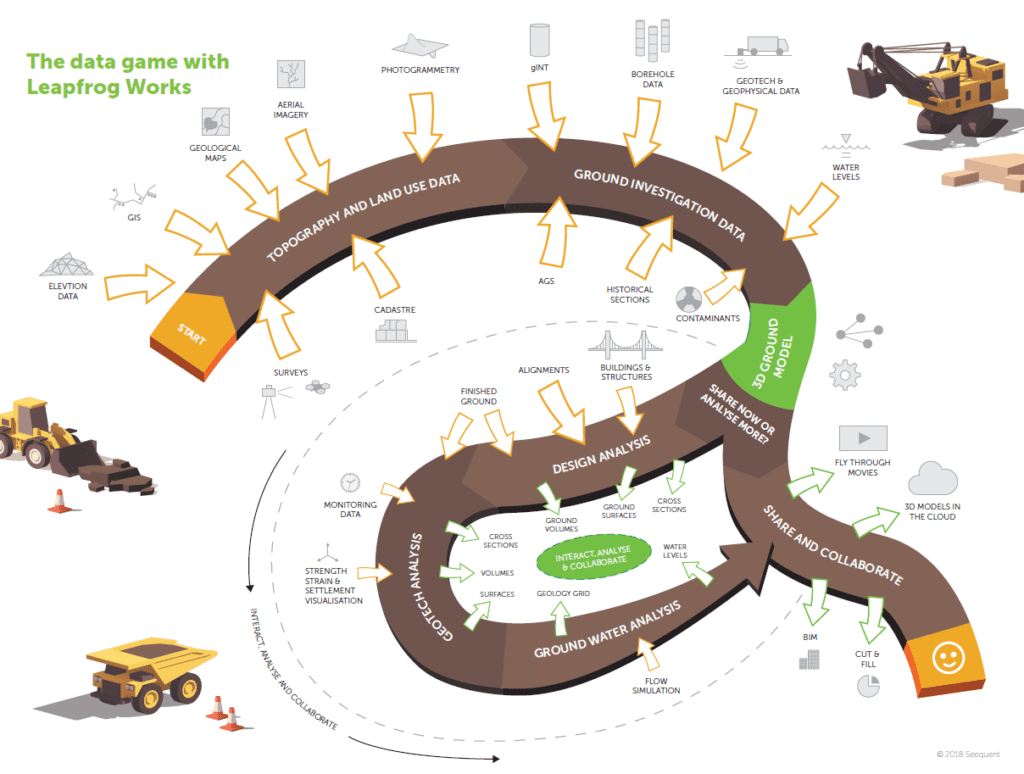Pat McLarin tackles 5 questions on the Civil and Environmental Industries’ elusive holy grail.
What does the industry want?
Principally, engineering geology and geotechnical practices want to be able to handle whatever data is thrown ‘over the fence’ at them. As service-oriented departments or consultancies, they need to be able to say ‘no problem’ and get on with assembling and analysing data, identifying the gaps that need closing, and building an understanding of what lies beneath the surface.
What they don’t want is to have to go back to a potential client and ask for the file in a different format. It just makes them look unprepared. They’ll scour the Internet for free conversion software, or call a friend in the GIS or CAD department to do them a favour. Not a great solution…
On the flip side they want to be able to deliver the model outputs in a form that meets their clients requirements, without compromise. That means everything from a fully interactive 3D model in a web viewer, to a BIM federated model to cut and fill estimates in a costing spreadsheet, to a 2D cross-section for inclusion in a report.
Why is it so complex?
Geological modelling typically requires every bit of data you can lay your hands on in order to shed light on what’s going on beneath the surface. This means that modellers have to cope with some pretty disparate sources. They end up running the gamut of data from above and below the ground, as well as spanning the past, present and future.
Just think about ground surface data for a minute. It comes from GIS databases, geological maps, CAD plans and historical surveys, aerial photographs or satellite-based raster images. Increasingly today it’s also from drone-based aerial surveys, terrestrial scanners and mobile surveying and mapping applications, and they generate considerable quantities of data.
The same goes for subsurface data. The AGS data format, for example, contains dozens of different data types for ground investigations. In fact, it is itself a response to the complexity of ground investigation data types by the industry.
So why don’t we all natively use a common format to make it easier to share information? Well, the complexity comes because each individual data source tends to be optimized to make it’s part of the puzzle more productive and valuable. And these optimizations are actually quite beneficial to the industry.
An example of this would be our own FastRBF™ surfaces that we generate in Leapfrog Works. Because we control the mathematics behind the surfaces we can optimize the performance, which in turns makes fast dynamic geological modelling accessible to the industry, however, the same type of surface wouldn’t suit the CAD world which is more about drawing straight lines and regular shapes of manmade structures.
The trick is to also support and contribute to the development of open exchange formats so that the models can be shared in all their 3D glory. Yet at the same time you’re supporting traditional modelling outputs like 2D cross-sections for inclusion in paper-based reports that are still a standard part of industry practice.

What are the main challenges?
There are certainly ongoing issues around the direct support of the many data sources that are available; to cope with ever-increasing amounts of data; to handle continual updates in data. Right now, a key challenge is for the ground engineering disciplines to participate as an equal partner in BIM-style workflows on major construction projects.
On infrastructure projects, uncertainty and risk relate to how well you are able to successfully predict the ground conditions. However, communication between ground engineers and their civil and structural counterparts regarding the degree of risk is subject to miscommunication.
Adopting a BIM philosophy helps all disciplines in a project get on the same page by creating a single source of truth, so it is a natural extension to integrate the ground model in these workflows. In fact, it’s long overdue. It’s also worth noting that BIM standards are much more advanced for vertical infrastructure, so there is work to be done to standardise what it means to be an interoperable ground model.
What is Leapfrog doing to help?
A lot of the work last year was about removing barriers to interoperability through the support of key formats needed by the industry. Among others we support…
- geodatabase and shapefile formats for GIS data
- dxf and dwg CAD formats for incorporating engineering
design data - and AGS and gINT database formats for direct connection to
- the source of truth for ground modelling.
We have always been a 3D centric company, so for us 3D comes easy. But there is a still a need to create 2D cross section outputs for interoperability with other workflows like 2D geotechnical analysis, or for baseline reports and structural engineering analyses.
It’s interesting and refreshing to see more and more workflows completed in 3D as digital data becomes more prevalent and computers ever ‘gruntier’. However we still envisage a continued need for 2D outputs in the foreseeable future, so we’ll continue to improve our cross-section feature set.
Right now, though, we are prioritising BIM interoperability and support of the IFC format for 3D ground models. It means geotechnical professionals will have an equal footing and position with the inclusion of their own geological interpretations directly in the project BIM environment.
Beyond that, our next priority is for the inclusion of rich descriptive
information in the model that enables it to be self-documenting in
those workflows.
Why is interoperability important?
At the end of the day it is about improving understanding in both directions. The Geotech understands what is planned to be built, and where, and can share what will be encountered and the risk or opportunity that comes with it.¥All that is enabled by taking a pragmatic and open approach to data interoperability.
To be realistic, it’s not practical to directly support every last format that anyone might want to bring into a Leapfrog project, so we’ll continue to rely on and support industry standards for data exchange.
But overall our goal is to empower geotechnical professionals with the tools that help them understand what is going on with the other disciplines on the project, and share and tell the story about what is happening beneath the surface that other disciplines and project stakeholders need to know.

Product Owner
Seequent





